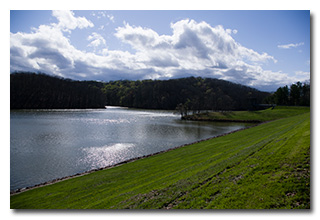
by William Eric McFadden
From the Wayne National Forest website:
-
The Wayne National Forest is a patchwork of public land that covers over a quarter million acres of Appalachian foothills of southeastern Ohio. The Forest is divided into three units managed out of two Ranger District offices located in Nelsonville and Ironton, with a field office in Marietta.
The Forest features over 300 miles of trails for hiking, all-terrain vehicle riding, mountain biking, or horseback riding in season. The trails are open to ATVs, mountain bikes, and horseback riders from mid-April to mid-December each year. Come visit the Wayne and hike or ride our trails!
From the North Country National Scenic Trail website:
-
Come to the North Country. Trek the hills and valleys. Stand on the shores of lakes & streams from glaciers 10,000 years before. Clear-flowing water, red/gold of autumn, a fairyland of snow, open prairies, and distant horizons paint the land. Historic sites along the way tell how America settled and grew as a nation. From North Dakota to New York (and soon Vermont), adventure is never far away.
Pictures
Description
 On Sunday, April 11, 2021, one member of the Southeast Ohio Radio Adventure Team
performed a successful two-fer activation of Wayne National Forest (K-4521) and North Country National Scenic Trail
in Ohio (K-4239) as part of the Parks on the Air (POTA; link) program.
Eric McFadden, WD8RIF, performed the quick two-fer activation at Tom Jenkins Dam on a cool and very blustery early Spring
day. This would be Eric's sixteenth POTA activation of Wayne National Forest and his fifteenth POTA activation of
North Country National Scenic Trail.
On Sunday, April 11, 2021, one member of the Southeast Ohio Radio Adventure Team
performed a successful two-fer activation of Wayne National Forest (K-4521) and North Country National Scenic Trail
in Ohio (K-4239) as part of the Parks on the Air (POTA; link) program.
Eric McFadden, WD8RIF, performed the quick two-fer activation at Tom Jenkins Dam on a cool and very blustery early Spring
day. This would be Eric's sixteenth POTA activation of Wayne National Forest and his fifteenth POTA activation of
North Country National Scenic Trail.
Eric arrived at Tom Jenkins dam at about 1340 UTC and, finding the parking lot nearly empty, quickly deployed his 28½' wire vertical on the Jackite 31' telescoping fiberglass mast and drive-on mount. Because the cool temperature and very gusty wind, Eric chose to set up his KX3 inside the car. Eric was on the air at 1352 UTC.
As at previous visits to this location, Eric found he had good cell-signal and he was able to spot himself on the POTA Spots website and to use POTA Spots to identify possible Park-to-Park (P2P) QSOs.
Eric began operations by looking at POTA Spots to identify possible P2P QSOs and at 1356 UTC he made a 20m P2P QSO with NG5E who was activating Tawakoni Wildlife Management Area (K-6605) in Texas.
Finding a clear frequency on 40m, Eric spotted himself to POTA Spots and began calling "CQ POTA". QSOs came steadily if not particularly quickly and in about twelve minutes Eric had made nine QSOs on 40m.
After the run on 40m, Eric managed a single QSO on 20m and a single QSO on 30m.
Before calling it quits, Eric again looked at POTA Spots for possible P2P QSOs but no additional QSOs were made.
In all, Eric made twelve QSOs, including one P2P QSO. All of Eric's QSOs were CW and were made at the 5-watt level.
During his activation, the Ohio University Airport reported wind gusts of 29mph. The strong wind actually rocked Eric's car and at times Eric was concerned that his drive-on base would fail but, despite his fears, the simple wood-and-PVC contraption proved itself to be up to the task of supporting the 31' Jackite mast in the gusty wind.
Eric also submitted his log to the World Wide Flora and Fauna in Amateur Radio (WWFF; link) program for an operation at Wayne National Forest, KFF-4527.
(return)